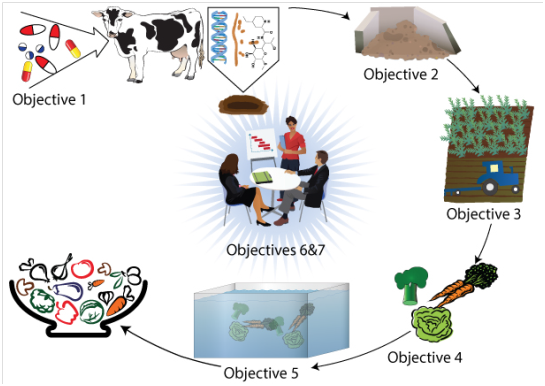Welcome!
Antibiotic resistance is a serious human health threat and there is growing evidence of linkages with antibiotic use in livestock. Overuse of antibiotics and residual antibiotics in manure may select for the survival of bacteria carrying antibiotic resistance genes (ARGs) and/or stimulate ARGs being transferred amongst environmental bacteria. While links between antibiotic use in livestock and antibiotic resistance in humans have been suggested, fundamental identification and understanding of how resistance is transmitted are limited, making strategies to reduce resistance difficult.
Our project, Identification and Management of Critical Control Points in the Spread of Antibiotic Resistance from Animal Manure to Raw Produce, researched these questions. Made possible by funding through a USDA NIFA Food Safety Challenge grant, this Coordinated Agricultural Project (CAP) incorporated an interdisciplinary and integrative approach to identify critical control points for antibiotic resistance transmission from manure to produce, to evaluate corresponding mitigation strategies, and to engage in education and extension efforts aimed at disseminating this knowledge to targeted stakeholders.

The specific project objectives included the following and are shown schematically in Figure 1:
Objective 1. Determine the effect of common therapeutic and subtherapeutic antibiotic use practices on excretion of antibiotics and ARGs, using dairy and beef cattle as models, in order to inform manure management strategies;
Objective 2. Examine the potential for manure composting to degrade antibiotics and attenuate ARBs and ARGs, and recommend appropriate manure treatment practices;
Objective 3. Examine the effect of soil type on the persistence of antibiotics, ARBs, and ARGs in compost-amended soils and provide guidance to farmers on implications for field selection;
Objective 4. Quantify the transfer of antibiotics, ARBs, and ARGs to various produce grown in soils amended with different compost types and provide guidance to farmers on crop selection;
Objective 5. Determine the effect of and develop recommendations for different fresh produce post-harvest practices on survival and re-growth of ARBs and ARGs;
Objective 6. Develop and implement educational opportunities focused on mitigation of agricultural sources of antibiotic resistance for undergraduate and graduate students;
Objective 7. Conduct extension activities in order to disseminate knowledge to relevant stakeholders about best management practices to preserve antibiotic effectiveness and protect community health.
For more information about the Project Team, Critical Management Points related to the project, FAQs, results, news updates, related upcoming events, or links to related resources, click on the navigation at the top of the page.
